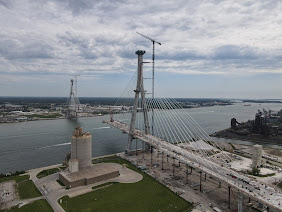On the south side of Detroit, MI, a new engineering landmark is steadily rising from the ground that will take its place among the great North American engineering achievements of the last 100 years upon completion.
Under construction for the last couple years, the Gordie
Howe International Bridge is a massive cable-stayed bridge intended to span the
Detroit River between Detroit, MI, USA and Windsor, ON, Canada. It will become
the largest such bridge in North America and the world upon its completion and
will feature A-shaped pylons that will stand 722 ft (220 m) tall, plus a center
span of about 2,800 ft (853 m). First proposed in 2004 as a means of supplementing the
already-existing Detroit River crossings in the area (the Ambassador Bridge and
Detroit-Windsor Tunnel), the project has gone through years of legal challenges
and environmental review. The existing Ambassador Bridge carries approximately
25% of all commercial merchandise trade between the USA and Canada, and the
need for a new crossing in the area to relieve the pressure on the bridge has been
apparent for several decades.
Under the guidance and ownership of the Windsor-Detroit
Bridge Authority, a joint venture contracting team was selected for the project
in 2018. Titled “Bridging North America”, this team consists of world-renowned
engineering and construction firms such as AECOM (lead design firm), Dragados, Fluor,
and Aecon (not to be confused with the above "AECOM") (construction contracting companies). The more than $4 billion USD project got
underway in 2019 with significant land clearing for the Ports of Entry and
bridge approach roadways and was originally expected to open to traffic in late 2024. Recent developments and progress updates have pushed that forecasted opening to 2025 as of September 2023.
Among the perks of this project are new and more modern Port
of Entry facilities on both sides of the Detroit River, plus direct
freeway-to-freeway access between Interstate 75 in Detroit and Highway 401 in
Windsor. The existing crossings between the two countries currently rely on tedious
local street connections in order to make the connection to the regional
freeway networks on both sides of the border. By locating the new bridge where
they have, officials on both sides of the border are aiming to increase the
efficiency of this international crossing and remove excess commercial traffic
from the local street grids of the two cities involved. Having said all of this,
it is the strong opinion of the author of this article that both existing
crossings should be kept open and maintained following the completion of the
new bridge. The need for cross-border redundancy is necessary now more than
ever, and the Ambassador Bridge especially is more than capable of serving
admirably as a sort of “back-up” facility in the years ahead. (A recent deck replacement
project was completed for this bridge in 2021 and the bridge is in otherwise
very good condition.)
The new bridge being built here is named for long-time
National Hockey League (NHL) star forward Gordie Howe, who’s illustrious Hall
of Fame career included 25 years as a player for the local Detroit Red Wings.
Howe led the Wings to four Stanley Cup championships during his tenure in
Detroit and was a 23-time NHL All Star across a career that lasted an unequaled
32 seasons (interrupted by a brief retirement following the 1970-71 season). This,
combined with his legendary career statistics and stature within North American
professional hockey, earned him the nickname of “Mr. Hockey” throughout the
continent. It is perhaps only fitting that a bridge of such towering dimensions
be named for such a towering figure in his sport on both sides of the border.
As a civil engineer who has worked on large-scale bridge projects over the course of his career, this project in Detroit is one I’ve taken a strong interest in ever since its proposal and contract award. It’s a project that will be continued to be followed in the Dan household over the coming years and its one I look forward to see completed in due course. The following pictures of the construction were taken in August 2022 from ground level from the American side of the project. Click on each image to see a larger version.
The following pictures of the construction were taken in September 2023 from the air from the Canadian side of the project. A DJI quadcopter drone was utilized for these images. This area of South Windsor offers ample opportunity to take in the scale of this project from the air, but please remember to do so safely and within the means of your experience and equipment level. Click on each image to see a larger version.

































































































Comments